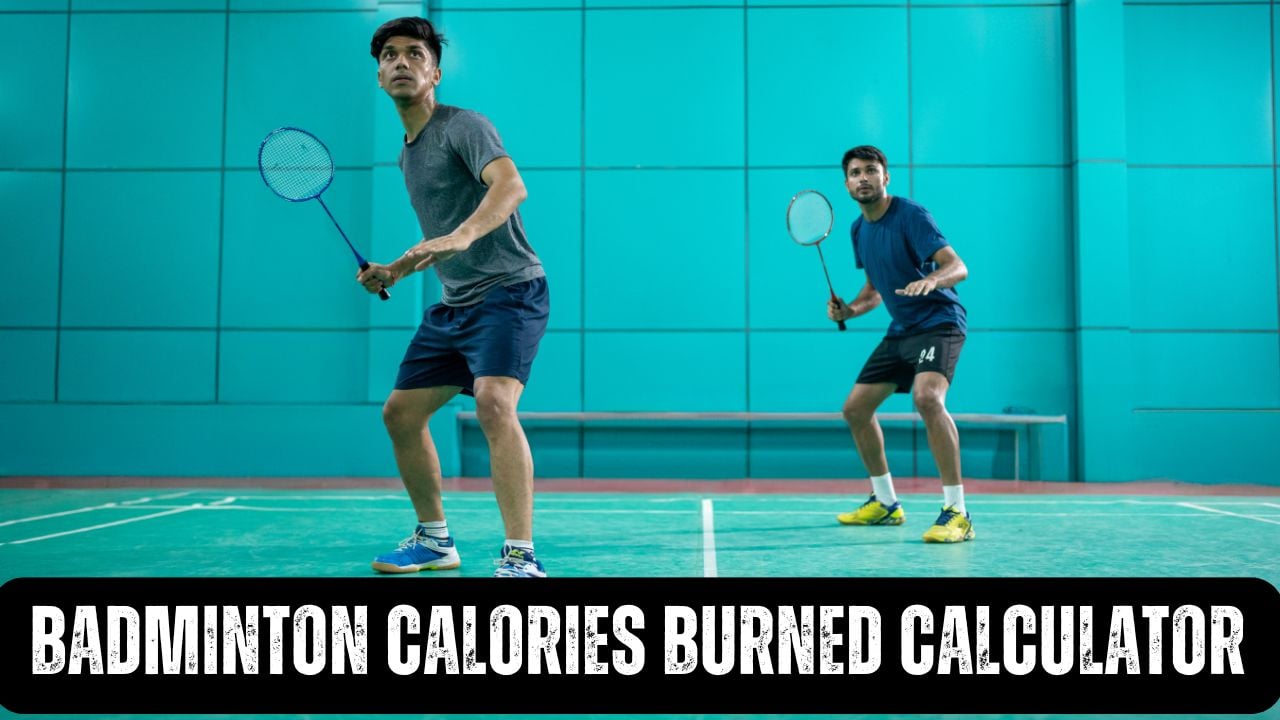Badminton Calories Burned Calculator
Calculate calories burned during badminton based on play intensity, duration, and your personal stats.

How Many Calories Does Badminton Burn?
Playing badminton burns approximately 300-500 calories per hour for recreational players, but can reach 650-800+ calories for competitive matches.Beyond calories, badminton improves cardiovascular fitness, coordination, balance, and reflexes. The social aspect also provides mental health benefits that solo workouts often lack.
How Different Badminton Styles Affect Your Calorie Burn
Based on the Compendium of Physical Activities, here’s my breakdown of badminton intensity levels:
- Social/Casual Play: 4.5 METs – Perfect for beginners, focusing on basic shots and rallies
- Moderate Singles/Doubles: 5.5 METs – Recreational competitive play with consistent rallies
- Competitive Doubles: 7.0 METs – Fast-paced matches with strategic positioning
- Competitive Singles: 8.0 METs – High-intensity matches with constant movement
Benefits of Badminton
According to scientific studies, badminton offers comprehensive health benefits:
- High Caloric Expenditure: Burns 300-500 calories per hour of play
- Cardiovascular Health: Improves heart rate variability and endurance
- Agility & Coordination: Enhances reflexes and hand-eye coordination
- Mental Sharpness: Studies show improved cognitive function and mental well-being
- Full-Body Workout: Engages multiple muscle groups simultaneously
- Bone Density: Weight-bearing movements strengthen bones
Badminton Calorie Burn Guide
| Duration | Social Play (4.5 MET) |
Moderate Play (5.5 MET) |
Competitive Doubles (7.0 MET) |
Competitive Singles (8.0 MET) |
|---|---|---|---|---|
| 30 minutes | 135-158 calories | 165-193 calories | 210-245 calories | 240-280 calories |
| 60 minutes | 270-315 calories | 330-385 calories | 420-490 calories | 480-560 calories |
| 90 minutes | 405-473 calories | 495-578 calories | 630-735 calories | 720-840 calories |
Calories Burned by Specific Badminton Activities
| Activity Type | MET Value | Calories/Hour (70kg person) | Key Benefits |
|---|---|---|---|
| Practice Drills | 4.5 | 270-315 cal/hr | Technique improvement, consistent movement |
| Recreational Doubles | 5.5 | 330-385 cal/hr | Social interaction, strategic thinking |
| Competitive Doubles | 7.0 | 420-490 cal/hr | Team coordination, quick reflexes |
| Competitive Singles | 8.0 | 480-560 cal/hr | Maximum cardio, full court coverage |
| Tournament Play | 8.0+ | 480-600 cal/hr | Peak performance, mental resilience |
*Calculations based on a 70kg person. Individual results vary based on weight, playing style, and intensity.
My Top Tips for Maximizing Your Badminton Workout
After coaching countless players, here are my proven strategies for optimal calorie burn:
- 🏃Move between shots instead of standing still
- 🎯Practice multi-shuttle drills for constant movement
- ⚡Include footwork exercises between games
- 🔄Rotate between singles and doubles play
Calculate Your Badminton Calorie Burn
The Science Behind Badminton Calories
Calories Burned = (MET × Weight(kg) × 3.5) ÷ 200 × Duration(min)
Here’s what each component means:
- MET Value: Energy cost of badminton (4.5-8.0 depending on intensity)
- Your Weight: Heavier players burn more calories during play
- Duration: Total time spent playing
- 3.5: Standard metabolic factor in exercise science
Smart Badminton Training Strategies
✅ Best Practices
- Warm up thoroughly before play
- Stay hydrated throughout sessions
- Use proper footwork techniques
- Maintain good court positioning
- Take regular recovery breaks
❌ Common Mistakes
- Skipping warm-up routines
- Using incorrect technique
- Overtraining without rest
- Ignoring proper footwear
- Playing through pain
🚨 Important Health Guidelines
For safe and effective badminton practice, remember:
- Start with proper technique training
- Progress gradually in intensity
- Use appropriate equipment
- Listen to your body and rest when needed
FAQs
How often should I play to see results?
For optimal fitness results, I recommend playing badminton 2-3 times per week, with sessions lasting 60-90 minutes. This frequency allows for adequate calorie burn while providing sufficient recovery time. Beginners should start with shorter sessions and gradually increase duration and intensity.
Singles or doubles for better calorie burn?
Singles typically burns more calories (up to 8.0 METs) due to greater court coverage, while doubles averages 5.5-7.0 METs. However, doubles often allows for longer play duration. I recommend mixing both formats: singles for maximum intensity and doubles for endurance and skill development.
How can I increase my calorie burn during play?
To maximize calorie burn, focus on movement efficiency: practice split-step technique, recover to court center quickly, and maintain a ready position. Include high-intensity drills between games, such as shuttle runs or footwork patterns. Remember, better technique leads to longer rallies, which naturally increases calorie expenditure.
Related
- HIIT Calories Burned Calculator
- Zumba Calories Burned Calculator
- Circuit Training Calories Burned Calculator
- Plank Calories Burned Calculator
- Burpee Calories Burned Calculator
- Sit-Up Calories Burned
- Jumping Jack Calories Burned
- Pull Up Calories Burned Calculator
- Push-Up Calories Burned Calculator
- Home Activities Calories Burned Calculator
- Exercise Calories Burned Calculator
- Running Calorie Calculator
- Walking Calorie Burned Calculator
References
- Conger SA, Herrmann SD, Willis EA, Nightingale TE, Sherman JR, Ainsworth BE. 2024 Wheelchair Compendium of Physical Activities: An update of activity codes and energy expenditure values. Journal of Sport and Health Science, 2024;13(1): 18-23.
- Herrmann SD, Willis EA, Ainsworth BE, Barreira TV, Hastert M, Kracht CL, Schuna Jr. JM, Cai Z, Quan M, Tudor-Locke C, Whitt-Glover MC, Jacobs DR. 2024 Adult Compendium of Physical Activities: A third update of the energy costs of human activities. Journal of Sport and Health Science, 2024;13(1): 6-12.
- Owen N, Healy GN, Matthews CE, Dunstan DW. Too much sitting: the population health science of sedentary behavior. Exerc Sport Sci Rev. 2010 Jul;38(3):105-13. doi: 10.1097/JES.0b013e3181e373a2. PMID: 20577058; PMCID: PMC3404815.
- Cabello-Manrique D, Lorente JA, Padial-Ruz R, Puga-González E. Play Badminton Forever: A Systematic Review of Health Benefits. Int J Environ Res Public Health. 2022 Jul 26;19(15):9077. doi: 10.3390/ijerph19159077. PMID: 35897446; PMCID: PMC9330062.
- Chen CJ, Ryuh YJ, Donald M, Rayner M. The impact of badminton lessons on health and wellness of young adults with intellectual disabilities: a pilot study. Int J Dev Disabil. 2021 Feb 5;68(5):703-711. doi: 10.1080/20473869.2021.1882716. PMID: 36210894; PMCID: PMC9542256.
- Patterson, Stephen & Pattison, John & Legg, Hayley & Gibson (nee Knowles), Ann-Marie & Brown, Nicola. (2016). The impact of badminton on health markers in untrained females:. Journal of Sports Sciences. 35. 1-9. 10.1080/02640414.2016.1210819.

Manish is a NASM-certified fitness and nutrition coach with over 10 years of experience in weight lifting and fat loss fitness coaching. He specializes in gym-based training and has a lot of knowledge about exercise, lifting technique, biomechanics, and more.
Through “Fit Life Regime,” he generously shares the insights he’s gained over a decade in the field. His goal is to equip others with the knowledge to start their own fitness journey.
